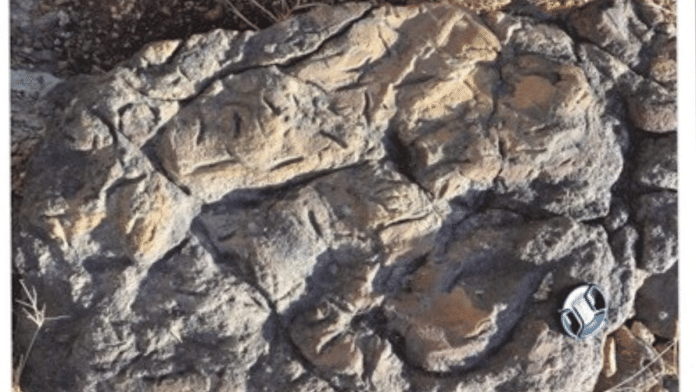New Delhi: Scientists from Jodhpur have found trace fossils—which are not body-part fossils but ‘traces’ of living beings left behind years after their death—that suggest prehistoric marine worms known as polychaetes once occupied what is the present-day desert city of Jaisalmer.
They have detected small hollow grooves in rocks, made by burrowing and slithering activity by these worms, which have been fossilised over millions of years.
These grooves, called Sulcolithos variabilis, are confirmation that prehistoric worms existed in the present-day Jaisalmer back when it would have been part of an oceanic environment, according to a study by scientists from Jodhpur’s Jai Narain Vyas University.
These groove-like structures are remnants of their movements on what would have been then an ocean-floor.
What’s more, back in 2021, scientists had found fossils of shark teeth from the Jurassic Period (168 to 157 million years ago) in the same region.
The new findings add to an expanding understanding of the prehistoric marine environment in current Rajasthan.
A paper published in Current Science on 28 May by the university detailed these discoveries, adding to the literature on fossils in the Jaisalmer Rock Formation.
This formation is a rock deposit from the Middle Jurassic Period, which lasted from 174 to 163 million years ago, and is home to a number of fossils that give insights into its geological history.
The Jaisalmer desert in India does not seem like an ideal spot for a marine environment, but many geological indicators point to a watery, possible marine past.
These include starfish trace fossils in 2014 and even clams and molluscs fossils in 2017, all dating to the Early and Middle Jurassic periods (200 to 168 million years ago).
The 400-metre thick Jaisalmer Formation is a sedimentary rock found in the northeastern part of the Jaisalmer Basin, and is largely made up of sandstones and limestones, and has five different layers known as members—Hamira, Joyan, Fort, Badabag, and Kuldhar. These members vary in rock types such as limestone, calcareous sandstone, and conglomerate.
The marine worm fossils were found in the Fort member, which consists of yellowish sandstone.
The grooves are 42-99 mm in length, and only 3-4 mm deep, meaning they are superficial marks. They are found abundantly in the rocks, around 40-50 per grooves square metre. They were made on semi-soft, calcium rich sediments, and the scientists posit that it was made when the worms were looking for food or moving around.
The Fort Member and other layers are also a great indicator of the larger environment of any rock formation, since the soil and terrain of each layer differ.
In the Jaisalmer Formation, the five layers indicate a shift from a terrestrial to a marine environment over the course of 100 million years during the Early and Middle Jurassic periods.

What are trace fossils?
The entire study, while focused on the existence of polychaetes in prehistoric times in the Jaisalmer Formation, doesn’t actually mention any fossils of the animals itself. It entirely relies upon another range of fossils which are officially known as trace fossils and are the ‘traces’ of animals and living beings left behind years after their death.
Other examples, famous ones, of trace fossils include footprints, bite marks, and even feces. In the case of the polychaetes, since they don’t have feet, they’ve left burrowing tunnels and channels in the rock.
“Unlike body fossils, trace fossils remain where they were millions of years ago. Since they’re burrowed into the earth, they aren’t eroded or transported by wind or air. So they are direct indicators of those animals’ behaviour years ago,” said Dr. Bhawani Desai, professor at the School of Energy Technology, Pandit Deendayal University, Gandhinagar.
“For animals like worms, which don’t have bones, it is difficult to study them historically. Their bodies don’t leave behind any remnants from the past, so trace fossils is what we rely on,” said Desai. “How else are we to know how they lived and behaved in prehistoric times?”
“The Jaisalmer Basin has been studied since 1800s by the British, because of its abundance of Jurassic-era sediments and fossils,” explained Desai. “Almost conclusively, we can say that it used to be a marine environment in that period.”
Trace fossils are very commonly used in geological studies, so much so that there are specific names for specific kinds of trace fossils. The kind that were found by the Jodhpur scientists are known as Sulcolithos variabilis because they’re burrowing/boring grooves which are elongated, straight and curved in shape. The Jodhpur scientists compared these trace fossils with similar ones found in Canada and Germany to confirm that they indeed belong to polychaetes.
While these fossils are not the first indicator of a marine environment in the Jaisalmer basin, they do add to the mounting evidence of a coastal environment in the region and help scientists to deconstruct the ecosystems of an ancient time.
(Edited by Ajeet Tiwari)
Also Read: ‘Beehive imprints’, not 550 mn-yr-old fossil: Bhimbetka find proven false, scientists accept mistake






